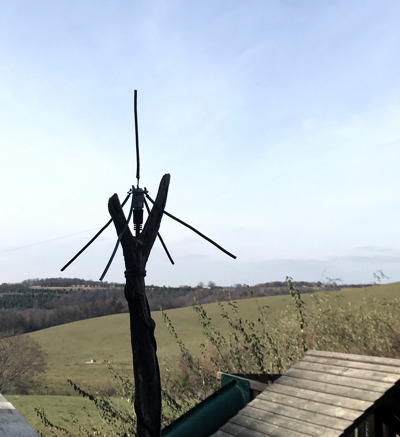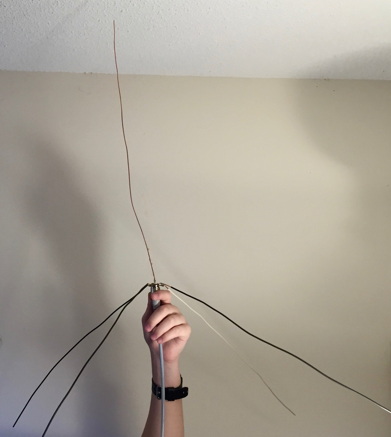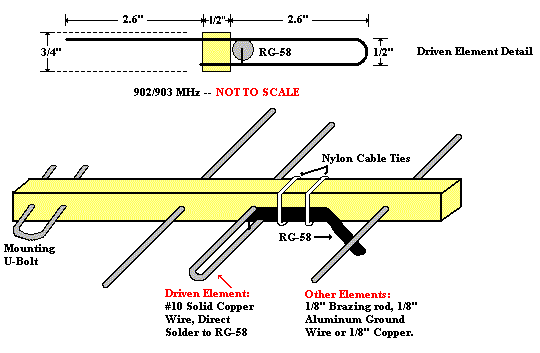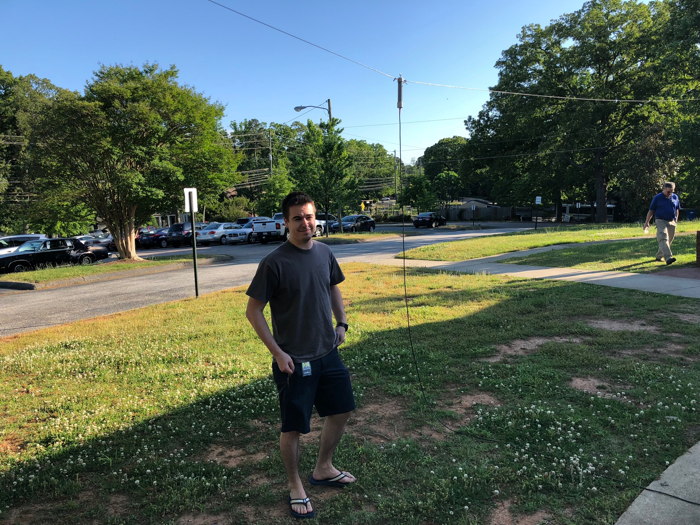Build Antennas
1/4 wave ground plane antenna
Here is a nice construction article on building a 1/4 wave ground plane.
This article makes it sound like you have to have accuracies of 1/8 inch or better, and you don't on 2m.
Also, the ground planes can be arbitrarily large. They just have to be longer than 1/4 wave length.
To calculate 1/4 wave, do this forumula:
(12*234) / FreqInMhz = length-in-inches
or you could use
234 / FreqInMhz = length-in-feet.
Build quarter-wave antennas .


You can build a multi-band ground plane by soldering multiple lengths of insulated wire into the top pin.
Spread the wires out at 45 degrees for an inch or so and then run them all up and down parallel to each other.
WA5VJB Cheap Yagi
cheap yagi antennas for 2m, 220, 440.

See also
WA5VJB CheapYagi PDF for another article on the same antenna.
Based on WA5VJB's design, N3LTV and I worked out a spreadsheet (Excel 2009 or later) to modify the numbers so we could pick a 420-450 center frequency for the antenna.
Download the spreadsheet from here.
Tape Measure Yagi
Construct a portable yagi out of PVC and using cut pieces of tape-measure for elements.
Measuring Tape YAGI for 2meters.
HF Dipole Antenna
A dipole consists of two 1/4 wave lengths of wire linearly placed (so they line up end to end) and fed from the middle, usually with coax.
A dipole is the simplest and most common of HF antennas. Most hams use antennas which are worse than a dipole for performance, sacrificing single-band performance for multiband versatility.
But dipoles are so easy to build that this should be the first antenna considered for many situations, especially new hams.
A dipole antenna for 40m is about 70 feet long.
234 / FreqInMhz = length-in-feet-of-quarter wave Use 2x this much wire.
For daytime operation, a 40m dipole located about 8' off the ground is ideal and will deliver communications out to 700 miles or so from a 100watt transmitter.
As a general rule, each band's requirements for best antenna placement is different from each other band.
Thus a multi-band antenna could be multiply compromised.
To construct a dipole the easy way and with nomimal performance, obtain a
1:1 balun. They cost $60 or so at a ham store.
Sometimes you find them at hamfests for $10 or so at a used table.
The balun will have heavy-duty rings for tying your antenna wire.
In addition there will be a lightweight copper wire on each side of the balun near the rings.
The lightweight wire is where the electrical contact must be for your antenna wire.
Loop your antenna wire through the rings and tie it in a knot, and then solder the stripped and tinned end of your antenna wire to the thin copper wire.
See the suppliers list for The Wireman, or QuickSilver Radio, for wire supplies, or check at the hamfest.

Tadd's comment on antennas
My understanding of antennas is really limited.
But.... i've found some rules of thumb to make things easy.
Note: In this context, "magic" is a synonym for "physics".
With my tongue-in-cheek method of antenna characterizations.. you have 4 types of antennas
- dipoles
- ground planes
- magic antennas that seem to work
- magic antennas that don't work.
#1 and #2 are really nice to play with and are often what we call Low Q.
Low Q is like a pickup truck.
It'll last for a long time and take abuse but it isn't particularly great as a race car.
High Q vehicles make better race cars but are finicky and break for the most trivial reasons.
The magic antennas can indeed work but they have interesting characteristics and are sometimes bizarre in their behavior.
If you use EZNIC you can do some interesting experiments and find antennas that seem to work but are nearly impossible to build to the plan you created with EZNIC.
I just love it when an antenna design which is 90 feet long has a piece in it which has to be spaced to a millimeter precision and then only with a meter attached to verify that it works the way the designed specified.
One of the bizarre behaviors I'm not fond of is when RF shows up at the location where there is a human.
RF is supposed to show up at your friend's antenna, or at the antenna of all the people around the other side of the planet.
It's not supposed to show up in your stereo, or in your computer, or in the IF and AF of the other radios on your bench.
If putting your hand on the coax changes the way the antenna behaves, MY read is that you have a problem.
BTW, there are antennas which don't use coax at all.
Balanced feed line is actually quite amazing stuff.
Building a dipole or loop fed with balanced feed line and with a balun right near your shack can actually be quite nice and low Q.
More on that in a different post.
I prefer antennas which make sense and don't let RF come back to the shack.
Some people get really good at this antenna stuff.
You might be one of those.
Some people are good at keeping a race car going.
So... trivial rules of thumb.
Look for an antenna where the feed point comes more or less to the middle of the antenna (and has a balanced to unbalanced transformer or something doing that job, or where there is a ground plane which is made of 1/4 wave radials at the longest wavelength you'll be transmitting at.
A 2m/70cm/23cm omni antenna will have 20-inch ground radials.
If it doesn't... there is magic in there someplace.
(in this context, "magic" is still a synonym for "physics").
BTW... this is not to besmirch people who really do understand this stuff.
But... I lead an effort in our local club to try to keep, retain, hold onto, and to get new hams to stay in the hobby.
Dumping serious theory at them when they are NOT asking for it, is not necessarily the ideal method of handling a question.
Many new hams use spooky physics antennas that work great.
Since 2010 or so, antennas called end-fed halfwaves have become quite popular.
There is no denying that my limited view on antennas is limited.
But, beware, there are some really crappy antennas out there which have popularity.
It is not hard to find antenna companies that lie about the antenna's performance.
To really know, we can talk about how to really test an antenna.
The most rational way to test an HF antenna is get two stations to talk to the same distant station and see who is louder to that distant station, while using the same power output of course.
It's even easier to test a VHF or UHF antenna.
Just get on simplex with somebody who has an S meter and then switch between two antennas.
Which one got a higher S meter reading at the distant station?
Move the two antennas a few feet and try again.
Do this with a few positions with each antenna and average the S meter readings for the each antenna.
Or maybe use 3 receiving stations, each with S meters, and average their reports.
Maybe it will be more obvious than that without need to average!
The reason you need to average is that on VHF and UHF the signals usually are plowing through trees and buildings.
The path the signal takes can be not at all straight.
Changing the antenna location can change its path and even several inches can make a big difference.
You can prove that yourself with an HT on a ducky.
Wander around inside the house and see how the signal from the repeater changes.

 You can build a multi-band ground plane by soldering multiple lengths of insulated wire into the top pin.
Spread the wires out at 45 degrees for an inch or so and then run them all up and down parallel to each other.
You can build a multi-band ground plane by soldering multiple lengths of insulated wire into the top pin.
Spread the wires out at 45 degrees for an inch or so and then run them all up and down parallel to each other.

